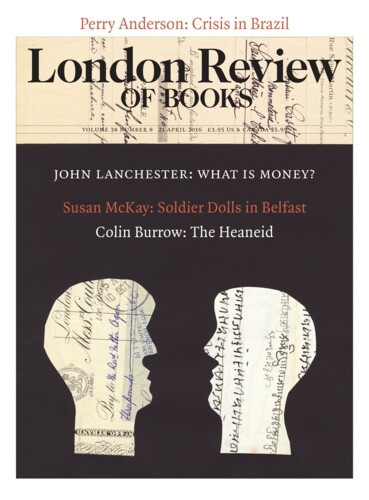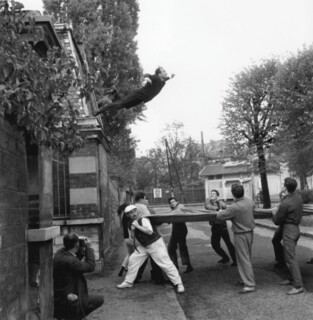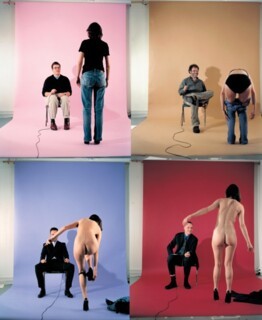The first picture you come across in Tate Modern’s vast and various exhibition Performing for the Camera (until 12 June) is Yves Klein’s arresting and now iconic Leap into the Void (1960). It’s the jumping-off point for the whole show and it features the artist himself, well, jumping off. He’s throwing himself from a building in a suburban Paris street and is captured in the photograph just as he takes the leap – one foot still touching the ledge, arms outstretched, his whole body arched ecstatically back as he anticipates his flight. He is wearing a suit and tie, a pair of smart shoes. A cyclist on the other side of the street pedals on, unaware or uninterested. One is left to imagine what comes next: lift-off, the artist transcendent; or the beginning of the descent, the man smacking down onto the tarmac below. As it happened, Klein, who was 32 at the time, died two years later – but nobody could argue with a random heart attack. The picture appeared on newsstands across Paris – for one day only – in a special supplement mocked up to look like the Sunday edition of France-Soir, a spectacular happening he later described as a ‘leap into the future of today’. A few months before Yuri Gagarin’s first manned orbit of the Earth, Klein showed that an artist didn’t need a rocket to launch him into space.
Close by the picture in the Tate exhibit is a photograph that debunks the whole thing (above). The jump, of course, was tightly stage-managed: in real life, a group of his friends held out a tarpaulin to catch him as he fell. The famous image – unexplained for forty years – is a photomontage made in the darkroom by Harry Shunk and János Kender, as was eventually revealed when their working materials made their way into the Roy Lichtenstein archives after Shunk died. In one shot, Klein hovering above the outstretched tarpaulin; in the other, the Paris street with the cyclist drifting by, minus the tarpaulin and team of nervous assistants. The final photograph is an act of trickery – a performance created for the camera. The Tate show traces a series of performance acts, images made for various reasons: as validations of existence, as acts of playfulness, as political statements.
Klein’s Anthropometries of the Blue Period records a performance he curated earlier in 1960 in front of a specially invited audience. In it he directs two nude female models as they cover themselves in his not yet trademarked blue paint, roll around in it and press their paint-covered bodies up against a large canvas hung on the wall. As with Leap, the whole event was photographed by Shunk-Kender and their pictures are more than just a record of the spectacle: they allow you to see it from all angles, and make you wonder who the audience is, or audiences are, and whether the women on the stage are the only people on show. The models are young, attractive and naked, and Klein, debonair in his suit, looks on with a high-minded expression at his ‘human paintbrushes’ as they smear themselves in paint. A small orchestra is playing. The women in the audience are in their most fashionable eveningwear and the men are smartly dressed. There is a discrepancy between their elaborate costumes and the nudity of the models: it’s a Déjeuner sur l’herbe transplanted into the high art studio. The audience are taking it all very seriously indeed. One or two of the men have their hands in their laps. The photographers are as interested in the watchers as the watched.
Women are often objects in this show, but they are also in charge of the images, controlling the way they are seen. In STRIP [Writer, Critic, Dealer, Curator, Critic, Writer] (1999-2000), Jemima Stehli takes her clothes off in front of a series of influential men from the art world (below). She has her back to the camera so that we see her strip off from behind – pull down her jeans, step out of her knickers, until she is standing naked in just her high-heeled black shoes. It is the watching men – their expressions, their body language and how it changes as Stehli removes each bit of clothing – who are the focus here, from the dealer who sits with his legs wide apart, deep in concentration, to the writer who sits with his knees together, a nervous look on his face. The men look worried, amused, confident, awkward, interested, fake-relaxed. It’s fascinating and terrible to witness.
Francesca Woodman began taking photographs when she was 13; she committed suicide at 22. In her self-portraits she is always shadowy, indistinct, half-seen. Her pictures look like dreams re-created, printed onto photographic paper. In one she sits by a table covered in what look like family portraits. The light falls on her pale hands, illuminating them, but the rest of her body, her own face, is in darkness. In another image she crouches behind an open umbrella so she is almost hidden, eyes shut. In one photograph we see her shoulder, her arm, as she holds out a banana. In another she is wearing black, arms raised above her head; next to her, hanging on the wall, is a black animal pelt. Her long body looks like it is hanging too; she is the same shape as the pelt. Elsewhere she has her hands raised up again, this time against a backdrop of trees, and her forearms are wrapped in bracelets of bark. She has become part of the forest around her, disappearing into her surroundings, losing herself. She is the girl who records herself and effaces herself at the same time. The two impulses – the impulse to fix her image on film and the impulse to disappear – make her work unlike anyone else’s. For all their ethereality, her pictures can be strongly physical: in one she is literally fixed down, naked on the floor, crushed beneath a heavy wooden door.
The exhibition includes many familiar performance photographs in its attempt to be comprehensive. There is Ai Weiwei’s trio of self-portraits showing him dropping a priceless Han dynasty urn, his face impassive. There is Man Ray’s image of Marcel Duchamp dressed as his drag persona, Rose Sélavy. He looks entirely comfortable, enigmatic, in his hat, fur collar and make-up. There are conversations between some of the photographs, and direct references too. Yasumasa Morimura’s A Requiem: Theatre of Creativity/Self-Portrait as Yves Klein (2010) is a restaging of Klein’s leap on a Japanese street, with a tram as well as a bicycle going by, busy street signs and a row of parked-up bikes. Cindy Sherman’s Untitled Film Stills are moments taken from non-existent ‘films’ that leave the viewer trying to figure out some kind of storyline or context. In one, Sherman, dressed in a jazzy black and leopard-print top, sits at a table with a cocktail glass and cigarette, tears and mascara running down her face making a mess of everything. She has been left, let down, abandoned; she didn’t see this coming. In another, she is smartly made-up, wearing an Audrey Hepburn-style headscarf outside a New York City building, looking straight at the camera with – perhaps – sorrow in her eyes. Over and over, there are fantasies realised, dreams portrayed, playfulness enacted. There are self-exposures here, nightmares on photographic paper, but just as many disguises.
Send Letters To:
The Editor
London Review of Books,
28 Little Russell Street
London, WC1A 2HN
letters@lrb.co.uk
Please include name, address, and a telephone number.



